Although it has been around for thousands of years, milk kefir is making a comeback in health communities.
It’s high in nutrients, probiotics, and is especially helpful for those with digestive complaints and gut health.
Since it has high amounts of probiotics, it can be a better choice as opposed to regular yogurt or drinking yogurts.
Kefir is also great to drink if you’re looking to lose weight or on any type of low carb diet.
What are Milk Kefir Grains?
Similar to water kefir grains, milk kefir grains technically are not grains.
The name is indicative of other food that simply is similar in shape and size. The cauliflower-like appearance, in this case, is created by the symbiosis of yeasts and bacteria and slightly matches that of wheat grains.
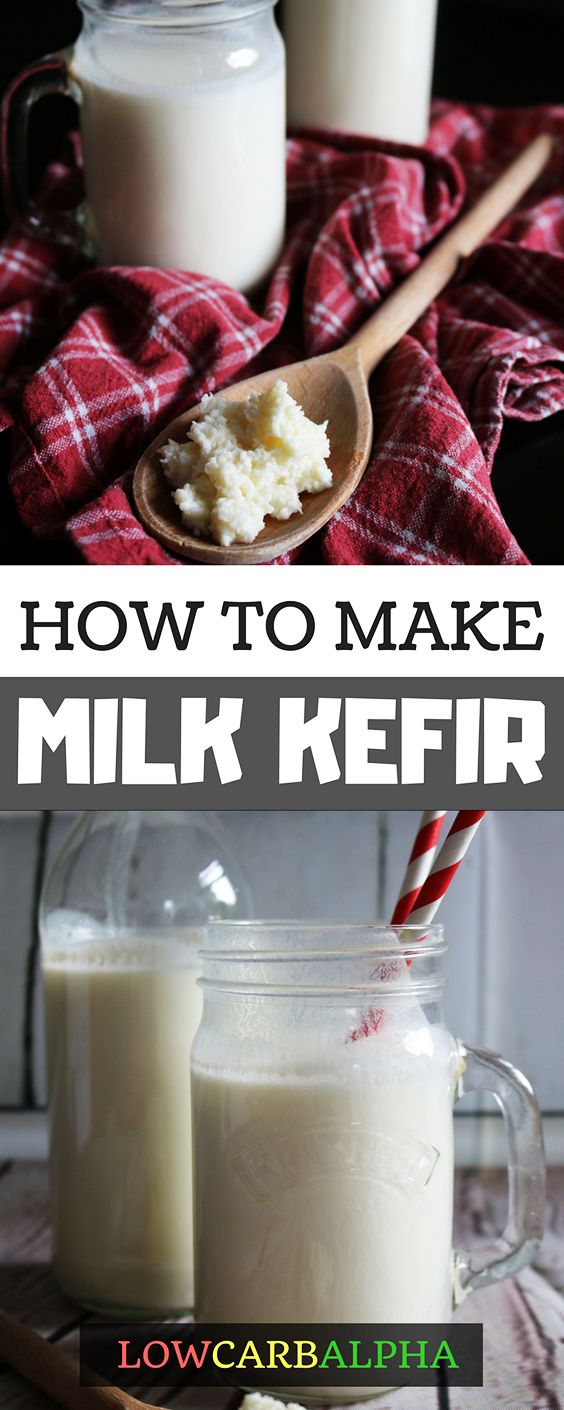
Rich in beneficial bacteria, enzymes, and healthful acids, this tangy health drink has been valued for its feel-good qualities.
Kefirs’ unique name comes from the Turkish word keif, which means “good feeling.”
Milk kefir has been cultivated for thousands of years and used as medicine to cure a wide variety of conditions in European and Asian countries.
It was traditionally a technique of preserving fresh animal milk to make it last longer.
The healthy bacteria and yeasts in the milk kefir grains cancel out unhealthy bacteria that could contrarily grow on milk left in room temperatures.
Store-bought milk kefir has sweeteners and other preservatives to help the product’s life expectancy.
Commercially mass-produced kefir has fewer cultures and probiotics than homemade varieties due to manufacturing constraints.
Kefir is one of the most powerful probiotic foods you can consume to benefit and regulate the health of intestinal bacteria whilst treating and preventing gastrointestinal diseases. (1)(2)
Homemade kefir by far excels all store-bought varieties in many ways.
It’s so easy to make a glass of milk kefir in the comfort of your home and is more natural than buying from your local store.
It takes less than 10 minutes to prepare and clean up, and you can choose how tangy you would like your kefir to taste.
If you’re following a diet low in carbs such as a low carb or ketogenic diet then be sure to include it in your daily macros.

Kefir grains strains of bacteria and yeast
Kefir has plenty of healthy bacterias and yeast and we’ve listed a few. (3)
Lactobacilli
Lactobacillus acidophilus
Lactobacillus fermentum
Lactobacillus fructivorans
Lactobacillus plantarum
Streptococci/Lactococci
Streptococcus thermophilus
Enterococcus durans
Yeasts
C. friedrichii
Cryptococcus humicolus
Kluyv. lodderae
Sacc. subsp. torulopsis holmii
Encouraging Milk Kefir Grains To Multiply
Kefir grains like an average room temperature of approximately 22°C or 71°F. Too cold of a climate, and they will become slow, sluggish, and can go to sleep.
If you live in colder countries, it will just take a bit more time to make the kefir.
Too hot of a climate, and the milk will ferment too quickly. It can create an unstable environment for the grains since it spoils faster than the grains can culture it.
Put in a cool dark place, out of direct light such as a cupboard in this case, and keep your home cool when possible.

Kefir Nutrition Facts
Kefir contains high amounts of vitamins such as vitamin A, Vitamin D, magnesium, biotin, folate, calcium, not to mention beneficial enzymes, and probiotics.
It’s also high in vitamin B12, which is great if you are following a vegan or meat-free diet.
Since kefir does not have a regulated nutritional content, the amounts vary considerably based on the animals, cultures, and so on.
No matter what the variety is, kefir has excellent nutritional benefits to fit in with your chosen low carb diet and ketogenic lifestyle.
Types of milk to use for milk kefir
You may be wondering now how to make homemade kefir to get these probiotics and nutrients.
There are several types of milk to choose from, such as cows milk, goats milk, or sheep’s milk.
If unsure of what to use, experiment with different types of milk and pick the winner.
If you are lactose tolerant then drinking milk kefir will improve lactose digestion and tolerance with lactose maldigestion. (4)

As a guide kefir grains work great with whole-fat animal milk, raw milk works really well, and you want to avoid all UHT or ultra-pasteurized milk as the kefir won’t grow well if at all.
You can use reduced-fat or non-fat milk, but you may notice that your grains do not grow well. It may perform sluggishly or take longer than usual to ferment the milk.
In this case, put them back in a jar of full-fat whole milk so to stimulate them.
As long as you use full-fat milk, you can drink a glass on a ketogenic diet.
To make a super thick and creamy fermented food, you can mix half milk half greek yogurt for a rich low carb probiotic yogurt.
Non-dairy milk such as coconut milk and almond milk is also an option.
As coconut or other non-dairy milk lacks the same proteins and nutrients as opposed to animal milk, the grains will lose their life after a short duration. Do this as a one-off or occasionally then restore them in animal milk.
Through experimenting, I’ve found milk kefir grains tend not to grow well with fruit, nut milk, and seed milk, and the taste isn’t all that great either.
What does milk kefir taste like?
If you’ve never tried milk kefir before then, the taste is somewhat similar to pourable and drinking yogurt.
Kefir is tangy, thick, and creamy, similar to a smoothie, and complete with healthy probiotics.
The differences between kefir and drinking yogurts are that it contains many strains of bacteria and yeasts, making it a particularly rich and distinct probiotic source.
As with all fermented foods, it has a tang depending on how long you let it sit.
Your milk kefir recipe will much depend on several factors, including brewing conditions, type of milk used, and more.
Kefir has multiple uses beyond simply as a smoothie. You can mix with other nutrient-dense foods and create healthy low carb and keto probiotic recipes.
You can use your milk kefir to make smoothies, soups, and ice creams. It’s an excellent replacement for buttermilk, and you can also strain the whey to make kefir cheeses.
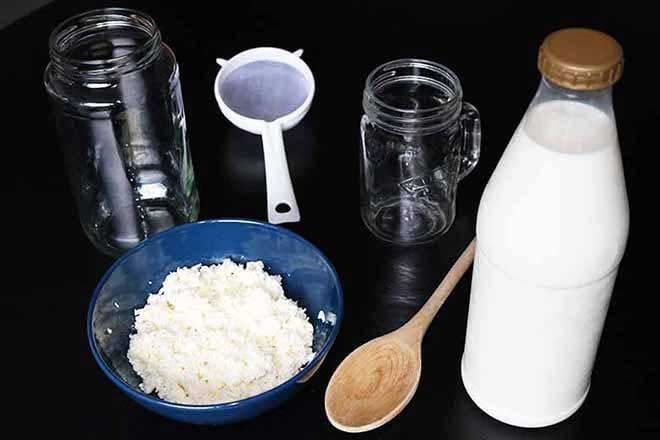

How to make Milk Kefir
How to make Milk Kefir With Kefir Grains. Easy Gluten-Free Low Carb Beverage
Ingredients
- 1 Tbsp Milk Kefir Grains
- 1 cup Full-Fat Milk
- 1 Mason jar , Or Glass Container
- Cheesecloth, Or Paper Towel
- Rubberband
- Small Plastic Strainer
- Storage Container With Lid
Instructions
- Spoon your milk kefir grains to a glass container and pour your cold or room temperature milk of choice over them then stir to combine.
- Cover the container with cheesecloth or paper towel to keep out dust and other little nasties. You could seal your jar with a lid instead, but bear in mind the kefir becomes more carbonated. Be sure to open it now and then to prevent the jar bursting and release the pressure in the jar.
- Let your milk ferment outside of the fridge for approximately 12-36 hours.
- You can check on your kefir regularly to see if the whey is separating from the milk, you may also shake the jar if you wish, I find it doesn’t make a difference to the end product.
- When you begin to see the whey separating, then it is more or less ready. It is all about the taste you prefer.
- Shake or stir together your finished kefir and pour into a container or a serving glass while using a plastic strainer to catch the milk kefir grains.
- Put your kefir grains back into their jar, add some more milk and repeat the method. To take a break from producing kefir, place the grains in fresh full-fat milk, cover, and chill in the fridge.
- Your kefir is ready to drink immediately or possibly use in a low carb recipe, but you may prefer to chill in the fridge before drinking.
Nutrition Information:
Yield: 1 Serving Size: 1 ServingAmount Per Serving:Calories: 154Total Fat: 8gSaturated Fat: 2gUnsaturated Fat: 6gCarbohydrates: 7gNet Carbohydrates: 1gFiber: 0gSugar: 6gProtein: 9g

Second Fermenting
Once grains have separated and you’ve finished transferring the milk kefir to a new jar. You can further culture and flavor to take on a unique taste through a second fermentation.
You can let your kefir ferment for an extra day or as long as you wish, according to your taste buds.
Taste your kefir frequently during its second ferment to understand the changes in flavor then choose the time that suits your zest.
Be aware again, the climate and conditions in your home will determine the second ferment time.
Second fermenting can be implemented to increase bacterial content and further reduce the lactose, or to develop the flavor additionally. (5)
Fermenting for the second time will mature the kefir and remove some of the sharpness that people associate with milk kefir.
Bear in mind any second ferments which contain sugar will increase the carbonation of your kefir.
There is no danger to the grains since they are removed before second fermenting, so experiment with adding different flavorings — ingredients such as fruits, fruit peels such as orange or lemon zest, or cocoa powder.
I sometimes like to add a dash of cinnamon or cocoa nibs but aim to keep the carbs low to maintain a ketogenic lifestyle.

Storing Kefir Grains
Whether or not you choose to consume kefir every day they can be stored safely and happily in fresh full-fat milk in your fridge for a couple of weeks as they have a deep sleep.
Do not repeatedly store them in the fridge since the good healthy bacteria will soon begin to die off.
If you’re after an extended rest from milk kefir, then you can also freeze them.
I’ve successfully frozen spare grains for 3 months and reused them after this time. If done correctly, there is no reason they can’t survive 6-12 months.
To freeze efficiently, wash the grains with cool filtered or boiled water.
Pat the grains dry between paper towels to remove residue moisture then coat them in a small amount of powdered milk to prevent freezer burn.
I sealed the milk kefir grains in a food sealer, which removes the air and locks out moisture, but you can just as well use a mason jar, plastic bag, seal, and put in the freezer.
To reactivate the frozen kefir grains, thaw for a few hours in the fridge. Once defrosted, rinse again with cool boiled or filtered water to remove the powdered milk then place them in fresh milk.
Discard the first batch or two since it will have some powdered milk and may take a few brews to get going again.
Thank you for reading and watching how to make milk kefir.
If you are watching carb intake, feel free to safely include a glass of the delicious cultured drink on a keto diet.
Please share this blog post, have fun fermenting, and enjoy making great tasting cultured milk kefir.

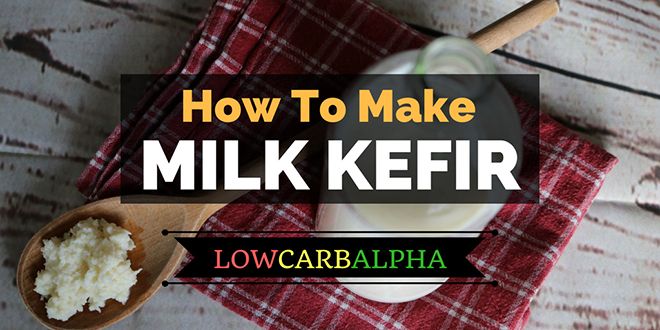


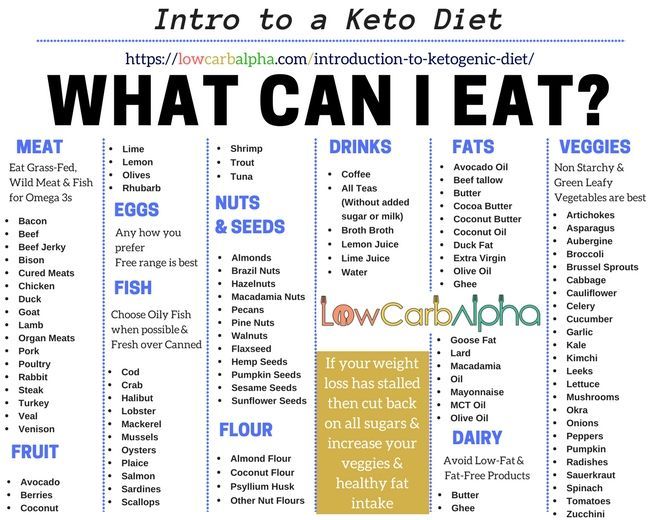
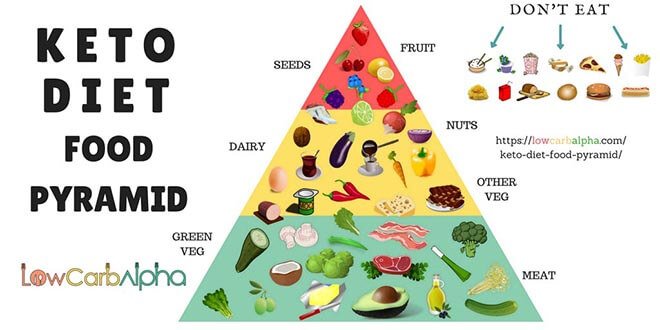


Where do you get the kefir grains from?
You can pick up some milk kefir grains here or you can find them in some local health stores.
Does the second fermentation change the nutritional count of the milk kefir?
Yes, second fermenting will increase B vitamin content, enzymes and bioavailability making it easier to absorb in the gut.
Hi there, just wanted to thank you so much for posting the macros for this! I’ve been trying to find more information on fitting kefir into a lchf eating plan, and it’s so hard to find for things other than commercially made kefir. Is it possible to find out where you got the calories/carb/sugar counts from? And are those for kefir left out for 24 hours?
For my purposes, I’m interested in using kefir grains to make kefir, and leave it out until it become kefir cheese, possibly 3-5 days, so I’m wondering how the nutritional info would change during such a period of fermentation. Thank you again for your help!
Hi Christy, I got the macronutrients from the label of the milk I was using.
The nutritional content of kefir would be roughly the same after fermentation. The sugar may be slightly reduced after fermentation.
Unless you are in a lab, there is no way of knowing. It is just approximate numbers.
With kefir cheese, you could weigh it and use the nutrition label from the milk and minus the carbs to get a rough idea of nutritional information.
Do you happen to know the nutritional content of double fermented milk kefir, double fermented an extra 24 hours?
There is no way of knowing the exact nutritional content but generally, the longer you ferment, the more you reduce the lactose and sugar content.
Longer fermentation increases probiotics and certain vitamins and minerals.
There must be some way of knowing…….some way of measuring the carbs in a cup of ripened kefir. The low-carb community would love to know.
According to this site, half a cup of home-brewed kefir has 2 carbs, so a full cup would be 4. That’s still pretty low.
https://www.fatsecret.com/Diary.aspx?pa=fjrd&rid=5676783
And here’s something I found which apparently confirms the 4 carbs per cup. Dr. Goldberg measured kefir in his laboratory and found that it has 2 carbs per half-cup.
http://www.livinlowcarbdiscussion.com/archive/index.php/thread-1536.html
I’m assuming this was for traditional, home-brewed kefir, not ripened kefir, which should have even fewer carbs.
On the other hand, someone in that discussion said that Dr. Goldberg’s methodology was flawed, and that he measured lactose, not carbs. So I dunno…..